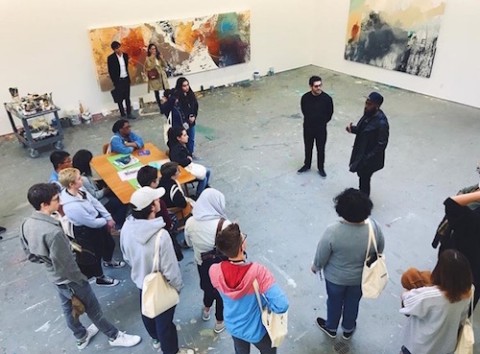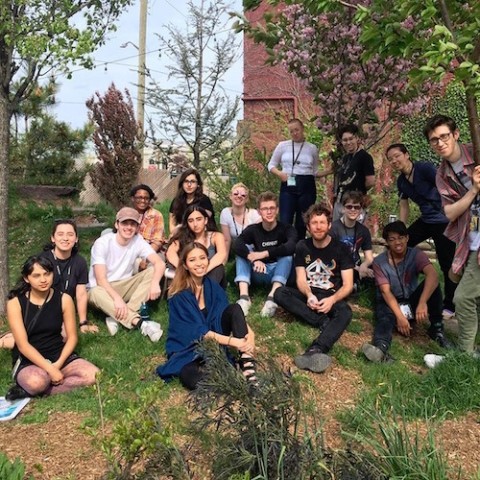José Parlá has arrived in Austin and is busy working on his monumental mural Amistad América. Robert B. Rowling Hall is still an active construction site and closed to the public, but you can follow his progress on Instagram @landmarksut. Even some of our staff hasn’t seen the artist at work so we invited UT sophomore Logan Larsen to tell us about his visit to Parlá’s studio in Brooklyn this spring.
My name is Logan Larsen and I am a sophomore majoring in Studio Art and Art History at UT. For the past year, I have worked with Landmarks as a Skyspace Attendant at James Turrell’s The Color Inside and volunteered with the Landmarks Preservation Guild and Landmarks Docents. This spring I was lucky enough to go to New York for a week with the National Young Arts Foundation, which awards students with both money and opportunities to visit or work with practicing contemporary artists. Through this program I was able to visit the studios of Mickalene Thomas, Marchesa, Dustin Yellin, and José Parlá. The studios were unbelievable! We had access to world renowned artists who had studios of my dreams. With José Parlá’s commission for Landmarks in the works, I want to share my experience visiting his studio.

National Young Arts Foundation visits José Parlá's studio in Brooklyn photo by Jordan Tiberio
His studio was a massive building in Brooklyn with huge ceilings and a loft space for his office, record collection, and a spectacular personal library. I confess that before visiting his studio I had never seen his work, but experiencing it for the first time in person made it an exceptional entry into his practice. Everything in his studio was in progress and because of this we got to experience a multitude of different stages. From my perspective, his process seemed fluid and open to spontaneity; it was more about the intuitive addition of surface and mark making and how that felt rather than a set image he was working towards. In other words, he let the paint be the paint. When in front of one of his works you get a sense of the surface and how much it plays a part in the materiality and experience of the piece. It’s all about the palpability of paint and this sense of time you feel in front of the work that makes viewing it in person so meaningful; something you can’t get from a photo online or in print.
Music seemed like one of the most important aspects of his process. Most of our studio visit was taken up by Parlá showing and playing parts of his extensive record collection. In fact, I would say that we spent more time listening and chatting over music then we did in front of his work. He pulled out a few of his favorite records and you could tell how the visuals in his work and the sounds paired up. They almost seemed like a collaborator in the work. The melding of the intense variety of music and the multiplicity of marks can only be experienced in person.

National Young Arts Foundation in Brooklyn photo by Jordan Tiberio
The week I spent in New York had a major impact on my practice as an artist not only because of the city’s aura and the great museums, but also because of the studio visits and artist interactions. That was something that I will probably never get the chance to experience again in such large quality and quantity. Being able to view an artist’s practice first hand was an invaluable experience because it gave me insight into their process and the reasoning behind why they make decisions. It was a far more valuable experience than viewing a finished work in a white cube gallery. Seeing other artists’ work inspired me to imagine where I should aim to go one day with my own practice.
Mark your calendars for the opening of Amistad América on Friday, 26 January 2018!
